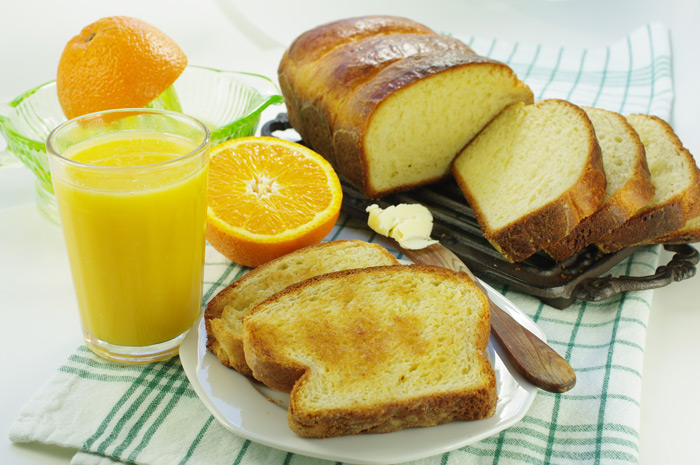Golden Brioche Loaves
(Makes 2 loaves)
Click here for a printable version of the recipe.
“Elegant” is the best word to describe this rich bread, with its golden color, unforgettable texture – pull on a slice and watch how it stretches luxuriously in thin, every widening lengths (one sign of a superior brioche – and slightly sweet, fully buttery flavor.
This is the basic recipe for brioche dough, and here it is formed into two loaves, each loaf comprised of four easy-to-pull apart sections, perfect for serving at breakfast – just add great jam and butter – or for turning into heavenly Sugar-Crusted French Toast, or if it lasts long enough to go stale, Bostock.
As with many yeast doughs, this one works best in larger batches, so please don’t downsize the recipe. If you don’t need two loaves, now, freeze one to enjoy later. Or shape half of the dough into a loaf and use the other half to make Pecan Honey Sticky Buns or Brioche Raisin Snails.
The first time I made brioche, I was taking a baking course and, so that we could get to know its properties, we made the dough by hand, beating everything into silky submission with a wooden spoon. I huffed and puffed harder and longer than I had when I’d run a marathon. Thankfully, while bakers of yore had only their energy and a spoon at their disposal, this is not the case nowadays. Today brioche is made with the flick of the switch on a heavy-duty mixer. This is one recipe that should not be made with a hand mixer – in all likelihood, the mixing will wear out the motor. So, either fire up the stand mixer or pull out your sturdiest wooden spoon.
The dough should be made 1 day ahead and then shaped and baked the next.
FOR THE BRIOCHE:
2 packets active dry yeast
1/3 cup just-warm-to-the-touch water
1/3 cup just-warm-to-the-touch whole milk
3-3/4 cups all-purpose flour
2 teaspoons salt
3 large eggs, at room temperature
1/4 cup sugar
3 sticks (12 ounces) unsalted butter, at room temperature but still slightly firm
FOR THE GLAZE:
1 large egg
1 tablespoon water
TO MAKE THE BRIOCHE:
Put the yeast, water and milk in the bowl of a stand mixer and, using a wooden spoon, stir until the yeast is dissolved. Add the flour and salt and fit the mixer with the dough hook if you have one. Toss a kitchen towel over the mixer covering the bowl as completely as you can – this will help keep you, the counter and your kitchen floor from being showered in flour. Turn the mixer on and off in a few short pulses, just to dampen the flour (yes, you can peek to see how you’re doing), then remove the towel, increase the mixer speed to medium-low and mix for a minute or two, just until the flour is moistened. At this point, you’ll have a fairly dry, shaggy mass.
Scrape the sides and bottom of the bowl with a rubber spatula, set the mixer to low and add the eggs followed by the sugar. Increase the mixer speed to medium and beat for about 3 minutes, until the dough forms a ball. Reduce the speed to low and add the butter in 2-tablespoon-size chunks, beating until each piece is almost incorporated before adding the next. You’ll have a dough that is very soft, almost like a batter. Increase the speed to medium-high and continue to beat until the dough pulls away from the sides of the bowl, about 10 minutes.
Transfer the dough to a clean bowl (or wash out the mixer bowl and use it), cover with plastic wrap and leave at room temperature until nearly doubled in size, 40 to 60 minutes, depending upon the warmth of your room.
Deflate the dough by lifting it up around the edges and letting it fall with a slap into the bowl Cover the bowl with plastic wrap and put it in the refrigerator. Slap the dough down in the bowl every 30 minutes until it stops rising, about 2 hours, then leave the covered dough in the refrigerator to chill overnight.
The next day, butter and flour two 8.5 x 4.5-inch loaf pans.
Pull the dough from the fridge and divide it into 2 equal pieces. Cut each piece of dough into 4 equal pieces and roll each piece into a log about 3-1/2 inches long. Arrange 4 logs crosswise in the bottom of each pan. Put the pans on a baking sheet lined with parchment or a silicone mat, cover the pans lightly with wax paper and leave the loaves at room temperature until the dough almost fills the pans, 1 to 2 hours. (Again, rising time will depend on how warm the room is).
GETTING READY TO BAKE:
Center a rack in the oven and preheat the oven to 400 degrees F.
TO MAKE THE GLAZE:
Beat the egg with the water. Using a pastry brush, gently brush the tops of the loaves with the glaze.
Bake the loaves until they are well risen and deeply golden, 30 to 35 minutes. Transfer the pans to racks to cool for 15 minutes, then run a knife around the sides of the pans and turn the loaves out onto the racks. Invert again and cool for at least 1 hour.
SERVING:
As soon as the loaves cool, they are ready to be sliced thickly and served, toasted or not, with butter and jam.
STORING:
Well-wrapped (cooled) loaves will keep overnight at room temperature. If you’d like, you can rewarm the loaves by wrapping them in aluminum foil and heating them for about 15 minutes in a 350-degree-F oven. The loaves can also be wrapped airtight and frozen for up to 2 months, defrost in the wrapping. |

